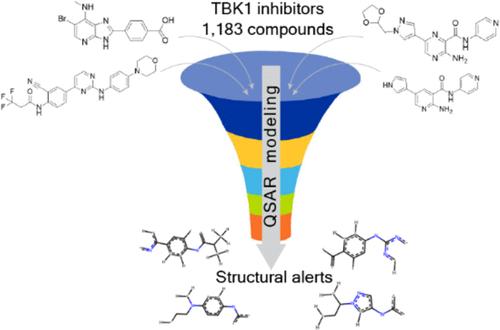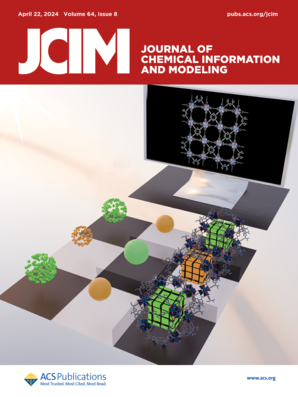In Silico Insights: QSAR Modeling of TBK1 Kinase Inhibitors for Enhanced Drug Discovery
IF 5.3
2区 化学
Q1 CHEMISTRY, MEDICINAL
引用次数: 0
Abstract
TBK1, or TANK-binding kinase 1, is an enzyme that functions as a serine/threonine protein kinase. It plays a crucial role in various cellular processes, including the innate immune response to viruses, cell proliferation, apoptosis, autophagy, and antitumor immunity. Dysregulation of TBK1 activity can lead to autoimmune diseases, neurodegenerative disorders, and cancer. Due to its central role in these critical pathways, TBK1 is a significant focus of research for therapeutic drug development. In this paper, we explore data from the CAS Content Collection regarding TBK1 and its implication in a large assortment of diseases and disorders. With the demand for developing efficient TBK1 inhibitors being outlined, we focus on utilizing a machine learning approach for developing predictive models for TBK1 inhibition, derived from the fragment-functional analysis descriptors. Using the extensive CAS Content Collection, we assembled a training set of TBK1 inhibitors with experimentally measured IC50 values. We explored several machine learning techniques combined with various molecular descriptors to derive and select the best TBK1 inhibitor QSAR models. Certain significant structural alerts that potentially contribute to inhibition of TBK1 are outlined and discussed. The merit of the article stems from identifying the most adequate TBK1 QSAR models and subsequent successful development of advanced positive training data to facilitate and enhance drug discovery for an important therapeutic target such as TBK1 inhibitors, based on an extensive, wide-ranging set of scientific information provided by the CAS Content Collection.

硅学洞察:建立 TBK1 激酶抑制剂的 QSAR 模型以促进药物发现
TBK1,即 TANK 结合激酶 1,是一种丝氨酸/苏氨酸蛋白激酶。它在各种细胞过程中发挥着至关重要的作用,包括对病毒的先天免疫反应、细胞增殖、细胞凋亡、自噬和抗肿瘤免疫。TBK1 活性失调可导致自身免疫性疾病、神经退行性疾病和癌症。由于 TBK1 在这些关键通路中的核心作用,它是治疗药物开发研究的一个重要焦点。在本文中,我们将探讨中科院内容集中有关 TBK1 及其在各种疾病和失调中的影响的数据。随着人们对开发高效 TBK1 抑制剂的需求日益强烈,我们将重点放在利用机器学习方法开发 TBK1 抑制预测模型上,这些预测模型来自片段功能分析描述符。利用广泛的 CAS 内容库,我们收集了一组具有实验测量 IC50 值的 TBK1 抑制剂训练集。我们探索了几种结合各种分子描述符的机器学习技术,以得出并选出最佳的 TBK1 抑制剂 QSAR 模型。文章概述并讨论了可能有助于抑制 TBK1 的某些重要结构警报。文章的优点在于基于中科院内容集提供的大量广泛的科学信息,确定了最适当的 TBK1 QSAR 模型,并随后成功开发了先进的正向训练数据,以促进和加强 TBK1 抑制剂等重要治疗靶点的药物发现。
本文章由计算机程序翻译,如有差异,请以英文原文为准。
求助全文
约1分钟内获得全文
求助全文
来源期刊
CiteScore
9.80
自引率
10.70%
发文量
529
审稿时长
1.4 months
期刊介绍:
The Journal of Chemical Information and Modeling publishes papers reporting new methodology and/or important applications in the fields of chemical informatics and molecular modeling. Specific topics include the representation and computer-based searching of chemical databases, molecular modeling, computer-aided molecular design of new materials, catalysts, or ligands, development of new computational methods or efficient algorithms for chemical software, and biopharmaceutical chemistry including analyses of biological activity and other issues related to drug discovery.
Astute chemists, computer scientists, and information specialists look to this monthly’s insightful research studies, programming innovations, and software reviews to keep current with advances in this integral, multidisciplinary field.
As a subscriber you’ll stay abreast of database search systems, use of graph theory in chemical problems, substructure search systems, pattern recognition and clustering, analysis of chemical and physical data, molecular modeling, graphics and natural language interfaces, bibliometric and citation analysis, and synthesis design and reactions databases.

 求助内容:
求助内容: 应助结果提醒方式:
应助结果提醒方式:


